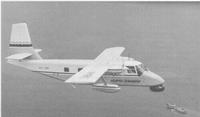


Chapter 7
I The First 100 Years 1788-1888
II Railways
III Motorised Vehicles
IV Aviation
i Local Inventions, Research, Design and Manufacture
ii The Development of Air Transport: The Trail Blazers
iii The Services
iv The Royal Flying Doctor Service
v Ground Aids and Safety Innovations
vi From Aviation to Modern Shipping
V Modern Shipping
VI Innovative Small Craft
VII Conclusion
VIII Acknowledgements
IX Contributors
References
Index
Search
Help
Contact us

Local Inventions, Research, Design and Manufacture (continued)
In 1944, studies began for the licensed manufacture of the Lancaster heavy bomber. This aircraft was rapidly improved into the Lincoln version and this was the version adopted for Australia. The first Lincoln flew in March 1946.The most remarkable feature of the wartime history of the Australian aircraft industry was its impressive growth. From a handful of people in 1937 and without a developed base of sub-contractors, it grew to 5,000 in June 1940 and to a peak of some 44,000 people in 1944 operating in four main factories and several annexes. Sub-contractors accounted for another 10,000 people. This industry delivered some 3,500 aircraft of all types to the R.A.A.F. and, at the end of the war, was capable of designing and manufacturing aircraft equal to the best in the world.[26] Even the licence-built aircraft were improvements on their originals: for instance the Beaufighter was more heavily armed than its British forebear and the Avon Sabre faster and more heavily armed than the original F-86.
After the war, the Beaufort Division, renamed the Government Aircraft Factories, undertook, in 1948, at the behest of the Commonwealth Advisory Aeronautical Research Council, the design and development of a pilotless target aircraft to be used in guided weapons trials at Woomera. This aircraft, called the Jindivik, first flew in 1952 and became the longest lived product of the Australian aircraft industry.[27] It is still in production in 1986 and over 500 Jindiviks of various versions have been produced; it has been exported to Britain, United States and Sweden. In 1953, a part of the design team at Government Aircraft Factories turned to guided weapons and began the development of a heavy anti-tank weapon, the Malkara. This device became the standard anti-tank weapon of the Royal Armoured Corps in Britain and over 1,000 Malkaras were exported to the United Kingdom.[28]
In 1960, the Government Aircraft Factories guided weapons design team was moved to the Aeronautical Research Laboratories (see below) to undertake the design and development of the Ikara anti-submarine weapon. The Ikara story is included in the Aeronautical Research Laboratories review.
It is important to appreciate the significance of these three remotely piloted aircraft/guided weapon programmes. Within the life of one project, Australian designers reached world state-of-the-art level and secured exports of high technology products. It is also noteworthy that the cost of local development was less than half of overseas development of equivalent projects.[29]
The last independent Government Aircraft Factories development was the Nomad utility aircraft. Its design started in 1969 and the first Nomad flew in 1971. Some 170 N22 and N24 Nomads were produced and, in addition to its use by the Australian Army and the Royal Flying Doctor Service, this aircraft was presented as military aid to Indonesia, the Philippines and Papua New Guinea and was exported to several countries, including the United States of America. The Nomad is a short take-off and landing aircraft, which utilises an ingenious system of spoiler-ailerons and full span flaps.[30]
The Nomad (Fig. 29), fitted with a 360 degree search radar, was also developed in the Searchmaster version for use in coastal surveillance missions. Nomad production ceased in 1982.

Organisations in Australian Science at Work - Aeronautical Research Laboratories; Australia. Department of Aircraft Production; Commonwealth Aeronautical Advisory Research Council (C.A.A.R.C.); CSIRO Aeronautical Research Laboratories; Government Aircraft Factories; Royal Flying Doctor Service
People in Bright Sparcs - Schaetzel, Stanley S.
 |
Australian Academy of Technological Sciences and Engineering |  |
© 1988 Print Edition pages 508 - 509, Online Edition 2000
Published by Australian Science and Technology Heritage Centre, using the Web Academic Resource Publisher
http://www.austehc.unimelb.edu.au/tia/502.html